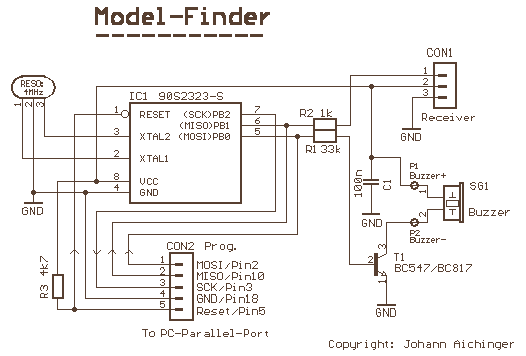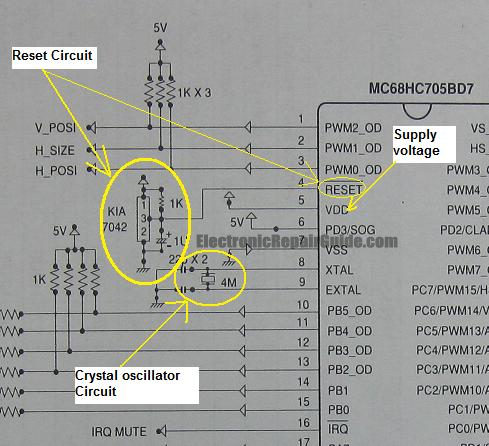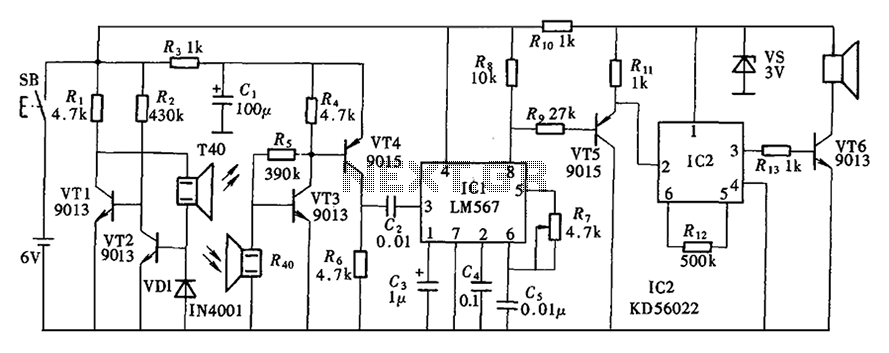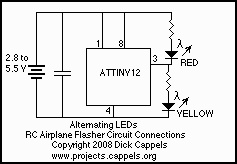
Air Model Finder

This simple circuit produces a loud trilling noise if no valid transmitter signal is received. This frequency must correspond with the resonant frequency of the piezo element; otherwise, the sound level will be very low. More: When you switch off the transmitter, the IC1, pin 5 provides a 2-KHz signal and pin 7 goes "high". If you use a buzzer with internal electronics producing the signal, R2 must be connected to pin 7 instead of pin 6.
The described circuit functions as an alerting mechanism that utilizes a piezoelectric element to generate sound in the absence of a valid transmitter signal. The core of the circuit is an integrated circuit (IC1), which is responsible for generating a 2-KHz square wave signal on pin 5 when the transmitter is switched off. This frequency is crucial, as it must match the resonant frequency of the piezo element to ensure optimal sound output; otherwise, the sound produced may be insufficient.
The circuit's operation hinges on the behavior of IC1's pins. When the transmitter is operational, pin 7 remains low, preventing the sound generation. Upon deactivation of the transmitter, pin 7 transitions to a high state, enabling the sound output. The presence of resistor R2 is significant in this context; its connection point determines the configuration of the circuit. If the sound-generating component is a buzzer equipped with internal circuitry to produce the signal, R2 must be connected to pin 7. Conversely, if the piezo element is directly driven by the output of IC1, R2 should be connected to pin 6.
Additional components may include capacitors for filtering and stability, ensuring that the output signal remains clean and free from noise that could distort the sound produced. Proper design considerations should also account for power supply requirements and the overall impedance of the piezo element to avoid damage to the IC or the sound-generating component.
In summary, this circuit effectively acts as an audible alert system, providing a clear indication through sound when a transmitter signal is not detected, utilizing simple yet effective electronic components to achieve its function.This simple circuit produces a loud trilling noise, if no valid transmitter signal is received. This frequency must correspond with the resonant frequency of the piezo element, otherwise the sound level will be very low. When you switch off the transmitter, the IC1, pin 5 provides a 2-KHz signal and pin 7 goes "high". If you use a buzzer with internal electronics producing the signal, R2 must be connected to pin 7 instead of pin 6. 🔗 External reference
The described circuit functions as an alerting mechanism that utilizes a piezoelectric element to generate sound in the absence of a valid transmitter signal. The core of the circuit is an integrated circuit (IC1), which is responsible for generating a 2-KHz square wave signal on pin 5 when the transmitter is switched off. This frequency is crucial, as it must match the resonant frequency of the piezo element to ensure optimal sound output; otherwise, the sound produced may be insufficient.
The circuit's operation hinges on the behavior of IC1's pins. When the transmitter is operational, pin 7 remains low, preventing the sound generation. Upon deactivation of the transmitter, pin 7 transitions to a high state, enabling the sound output. The presence of resistor R2 is significant in this context; its connection point determines the configuration of the circuit. If the sound-generating component is a buzzer equipped with internal circuitry to produce the signal, R2 must be connected to pin 7. Conversely, if the piezo element is directly driven by the output of IC1, R2 should be connected to pin 6.
Additional components may include capacitors for filtering and stability, ensuring that the output signal remains clean and free from noise that could distort the sound produced. Proper design considerations should also account for power supply requirements and the overall impedance of the piezo element to avoid damage to the IC or the sound-generating component.
In summary, this circuit effectively acts as an audible alert system, providing a clear indication through sound when a transmitter signal is not detected, utilizing simple yet effective electronic components to achieve its function.This simple circuit produces a loud trilling noise, if no valid transmitter signal is received. This frequency must correspond with the resonant frequency of the piezo element, otherwise the sound level will be very low. When you switch off the transmitter, the IC1, pin 5 provides a 2-KHz signal and pin 7 goes "high". If you use a buzzer with internal electronics producing the signal, R2 must be connected to pin 7 instead of pin 6. 🔗 External reference





